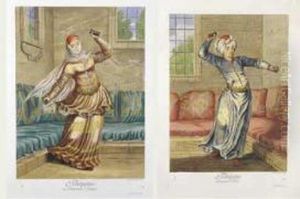Louis Gerard Scotin Paintings
Louis Gerard Scotin was a French engraver born in 1690. As an engraver, Scotin is considered part of the late Baroque period, which is characterized by its elaborate and highly detailed artistic style. While there is limited biographical information about Scotin's early life and training, it is known that he became an accomplished artist in the medium of engraving, which involves incising a design onto a hard, usually flat surface, by cutting grooves into it.
Scotin's body of work includes a variety of subjects, such as portraiture, decorative motifs, and historical scenes. His engravings were often made after paintings by other artists, which was a common practice at the time to disseminate artworks to a broader audience. Engravers like Scotin played a crucial role in the art world of the 18th century by creating reproductions of famous paintings which could then be collected by those who could not afford or access the original works.
He was part of a family of artists, with Gerard Jean Baptiste Scotin II (1698–1777) being a relative, possibly his brother, who was also an engraver. Scotin's work was well received, and he contributed to the spread of the Rococo style, which followed the Baroque period and was known for its more playful and whimsical qualities. Despite the prominence of his work, details about his personal life and training are not well-documented, which is not uncommon for artists of his time.
Louis Gerard Scotin passed away in 1775. While he might not be as widely recognized today as some of his contemporaries, his engravings still provide valuable insight into the visual culture of the 18th century and the methods of art reproduction and dissemination before the advent of modern technologies.
